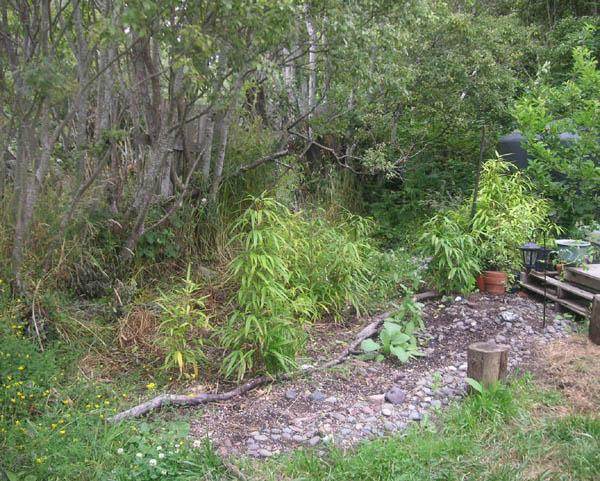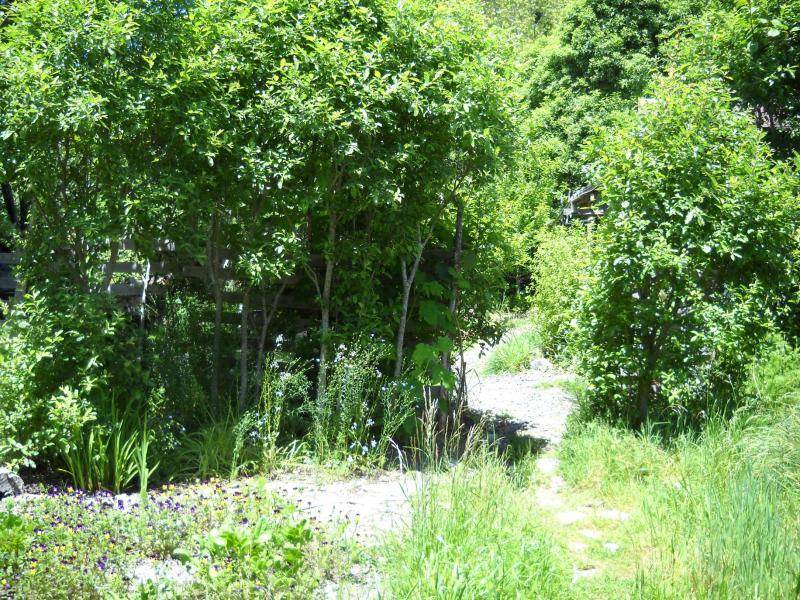i have a living fence that i have been working on for a few years.
i'm pretty fascinated with this idea, especially incorporating this into buildings and shelters....
so i have been experimenting and learning about this as i work on it. it is SLOW.
i would like to do some bigger projects like this, and use it to make living walls of food for houses, patios or sunrooms... and furniture! but...i have more ideas than i have time for, you know.
the plants in the living fence (the list gets longer every day as i keeping adding):
WILLOW
is the the most abundant, and forms the basic framework.
i keep replanting LOTS and LOTS of willow branches....and have gotten better at getting them to take. you have to water a LOT at first, thats the key.
you might not think so cause its so hardy, and if you do at the right time of year when the rains come it works way better.
some of the willow fence areas i put in didnt do that well, when i was first figuring it out. i was using too large pieces, and making a fence looking fence with scrap wood and free pallet pieces. but the pieces were too large, only the little branches, and especially fresh growth re roots well, and still you have to water all the time at first. sometimes a bit bigger taller piece will re root, a few of them did sprout new branches.
some of the sides of the fence are where some older willow trees fell down. so basically, the fence goes along the edges of where the willows fell down and made lines,and then grew back up from where they fell in rows. i keep adding to those already existing lines, and some spots have a fence looking fence, made of posts of willow that we cut down and pallet wood/salvage wood nailed onto them.
theres so many advantages to growing under and around the willows, that make up for the lack of sun light in some spots where they get thick.
they mulch my gardens with willow leaves without me having to do anything.
but its a lot of trimming, you have to trim it all the time, to keep it bushier and shorter and get back a bit of sunlight for the plants underneath. then it grows ten times thicker =) and its good to keep adding to it with the small stuff. its kinda constant, actually, it takes a LONG time.
blackberries, native and hymalayan
on a couple of sides and areas it has blackberries, which were already going strong when i started. i've pushed those back a LOT, ripped up roots, even put down some plastic and "garbage"...well scrap materials and random stuff to make blocks for the roots. they are a blessing, for sure, and work well, even if they can be a major pain in the butt! black berry wrestling is hard work.
but now they are growing in thicker and better and at the very outer edges and filling in the willows..and against the fence- and even just this week started getting ripe =)
then i built some raised beds, or sheet mulched and created beds on both sides along the fence....
planted lots of
fucshia
thimbleberries
elderberry
kiwis
flax
viola
nasturtiums
peas different kinds
clovers
artichokes
loquat (didnt take, putting more in)
mushrooms (havent seen any yet?), as well some natives popped up =)
love in a mist
mallows/ hollyhock (which also comes up randomly volunteering- the wild mallow)
arugula 2 kinds- common and wild
chard
sage
tomatillo, ground cherry
chammomile
naked ladies- they grow around here all over wild =) so put a few of these bulbs in
gooseberries
walking onions/garlic/onions/leeks in some spots here and there
three corned leek, cause they are abundant right here, so i spread them.
fig - just started, hope they make it =)
passionflower which has been very slow to establish unfortunately, cause this is a good one for this.
mugwort has gotten ENORMOUS !
and a small bed of calendula and beans, a large bed of brassicas, onions, garlic and potatoes +++
=================================
bamboo
-in one corner. this is one...i am liking it but it maybe isnt as good as some of the others. well i will happy when it finally grows in thick, but this is the only one i would rethink. where it is, i think it works, it will be great once it fills in. but i...hestitated to put it in, and had to come up with a plan to try to contain it.
its in a container in the ground, made out of scrappy stuff and plastic, some bag dirt, some random fill in soil, the soil i dug out to make the container, and +sh!t ! yes, sh!t of all kinds lines the bamboo box, that is lined with plastic and then layered with all kind s of building scraps (that were here in huge ugly piles)
to prevent the spread of the roots. then more plastic, then more sh!t of all kinds, some recycled bag dirt that i got free.
added some extra plants, three cornered leeks, and arugula, and lots of good volunteers started growing there too..
then theres another box that was a shipping container, that is filled in like a big pot, and ten big pots of extra bamboo roots and some starts.
originally i was going to keep it in pots, as a movable bamboo fence- but then i decided to build this "garbage" bed, to get rid of a bunch of sh!t as well ...and then plant the roots inside a large piece of plastic on top.
another thing is, theres a HUGE HUGE patch of bamboo (two kinds) that my neighbors are cultivating. so its basically like...those roots and plant would eventually get to that area...its a distance away now...but anywho...that stuff is already heading towards that corner anyway.
============================
ah theres some more, stuff that grows further inward from the fence where theres more light, lots of brassicas.... but thats enough.
alot of these plants arent really the supporting plants making the basic framework..... but its all gelled together pretty nicely by now and is getting better and better as i go.....and all the weaving climbing plants are pulling it all together more and more, while i keep planting more of the lower plants to stay close to the ground.
sometimes though its just really cluttered and the volunteers-weeds take over certain areas too making it pretty thick and cluttered up. but i like it that way anyway so thats ok.
volunteers:
clovers, white and red~ plantain~ sweet pea~ blackberries~ three corned leek~ yellow dock
thistles (though i weed these alot, sometimes i let some go)
and unfortunately the buttercups.
-this is my most dreaded plant "enemy" always trying to mulch these down and push them back as much as possible, with some other grasses and weeds that i mulch down.
stuff i would like to experiment with and add, just got some of these to add in
hazelnut starting some
any nut
honeysuckle
honeyberry really want to get some going
daylillies, or
canna ? looking for some
cherries starting some
hibiscus sprouted! soon to be in fence different kinds
figs, any ficus
plum
all kinds of
berries
fruit trees
guava (if your climate likes it)
wild and alpine strawberries sprouted, got some in there(wild ones) but more going in soon
roses starting some
and of course a variety of herbs, and foods, edibles or not...for the bottom parts, and places with more light
not for the support of the wall-
but i am mostly trying to do only edibles.
for growing a wall that was part of structure like i have been visioning for someday, the trees and such might not all be edibles, but a lot of edibles growing around the central trees. figs and hazelnut, other nuts, i think these would work ok as a wall for a cabin or as a wall for surrounding a patio/entrance area. the other really good ones for the main frame would be not edibles mostly (? well still looking for good ones, and researching), but which you could use to grow your edibles on like on a trellis.
i could post some pics here in a bit...find the links....figure out how to post a photo

 10
10




 4
4



















 3
3





 3
3




 4
4




 3
3














 2
2




 2
2








 2
2




 2
2




 2
2




 2
2








 2
2









 2
2








 2
2








 2
2












 2
2
















 2
2













 3
3




 4
4




 5
5




 4
4












